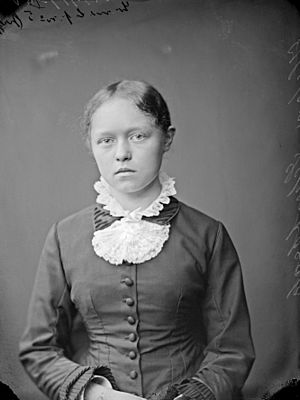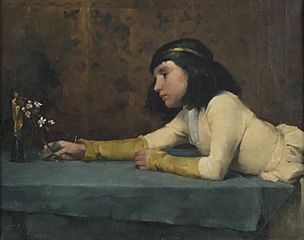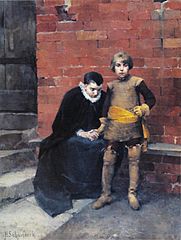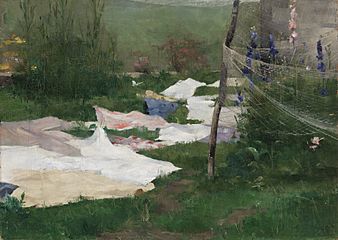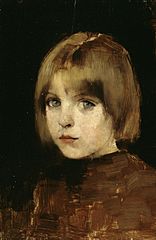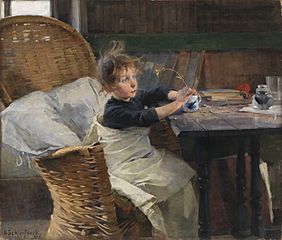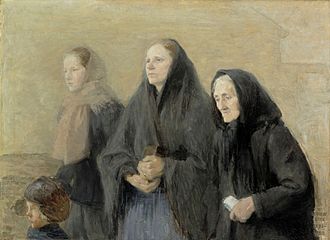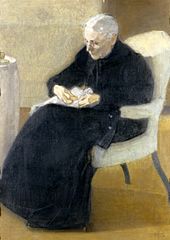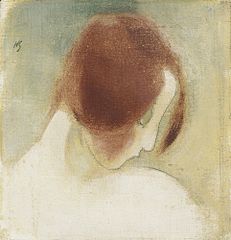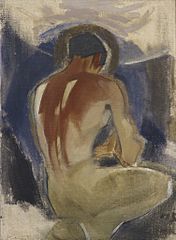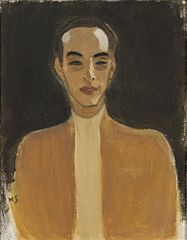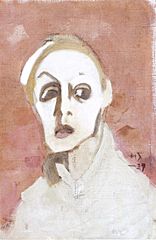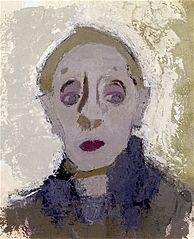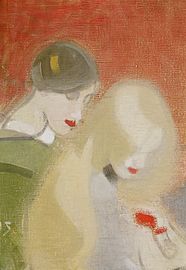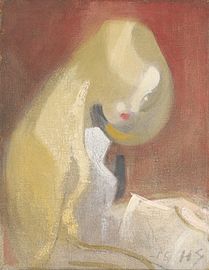Helene Schjerfbeck facts for kids
Quick facts for kids
Helene Schjerfbeck
|
|
|---|---|
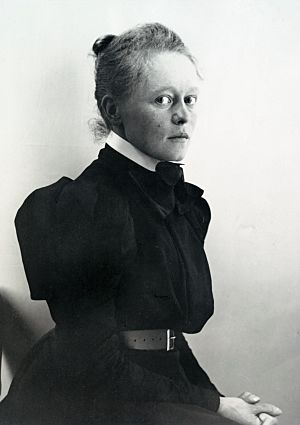
Early 1890s.
|
|
| Born |
Helena Sofia Schjerfbeck
July 10, 1862 |
| Died | January 23, 1946 (aged 83) |
| Nationality | Finnish |
| Known for | Painting |
| Movement | Naturalism (arts), Realism and Expressionism |
| Signature | |
 |
|
Helene Schjerfbeck (born Helena Sofia Schjerfbeck; July 10, 1862 – January 23, 1946) was a famous Finnish painter. She is known for her realistic paintings, especially her self-portraits. She also painted many beautiful landscapes and still lifes (paintings of objects).
Helene's art style changed a lot during her long life. She started with a realistic style influenced by French art. Over time, her paintings became more focused on portraits and still lifes. Early in her career, she painted historical scenes, like Wounded Warrior in the Snow (1880). These types of paintings were usually done by male artists back then. Her early works were not very popular at first, but they became well-known later.
Helene Schjerfbeck's birthday, July 10, is celebrated as Finland's national day for painted arts.
Contents
Early Life and Art School
Helena Sofia Schjerfbeck was born on July 10, 1862, in Helsinki, Finland. At that time, Finland was a special part of the Russian Empire called a Grand-Duchy. Her father, Svante Schjerfbeck, was an office manager. Her mother was Olga Johanna. Helene had one brother, Magnus Schjerfbeck, who later became an architect.
When Helene was four, she fell down some stairs and hurt her hip. This injury caused her to limp for the rest of her life and kept her from going to regular school. However, she showed a lot of artistic talent from a young age. In 1873, when she was eleven, she joined the Finnish Art Society School of Drawing. Adolf von Becker, who saw her talent, paid for her lessons. At this school, Helene became good friends with other artists like Helena Westermarck and Maria Wiik.
Helene's father died in 1876 from tuberculosis. To make money, her mother took in people who paid to live in their home. After graduating from the drawing school, Helene continued her art education. She studied at a private academy run by Adolf von Becker. There, she learned French oil painting techniques.
In 1879, at age 17, Helene won third prize in a competition. In 1880, her work was shown in an art exhibition. Later that year, she received a special grant from the government to travel to Paris.
Becoming an Artist
Studying in Paris
In Paris, Helene Schjerfbeck continued her art studies. She painted with her friend Helena Westermarck and learned from famous teachers like Léon Bonnat. She studied at the Académie Colarossi, a well-known art school. She received another scholarship, which allowed her to spend time painting in places like Meudon and Pont-Aven in France.
After returning to Finland for a short time, Helene went back to Paris in 1884. She continued to paint and study. She also made money by showing her paintings in exhibitions and illustrating books. During this time, she showed her art at The Salon, a famous art show in Paris. She also painted The Door (1884) in a chapel near Pont-Aven.
Travels and Important Paintings
In 1883, Helene became engaged to a Swedish painter named Otto Hagborg. However, their engagement ended in 1885. This was because a problem with Helene's hip, from her childhood fall, made his family think she had tuberculosis. Helene never married after this.
After a year in Finland, Helene traveled back to Paris in 1886. She received more money to travel and went to St Ives, Cornwall, in Britain in 1887. There, she painted The Bakery (1887) and The Convalescent. The Convalescent won a bronze medal at the 1889 Paris World Fair and was later bought by the Finnish Art Society. During this time, Helene painted in a naturalistic style, often outdoors.
Teaching and New Styles
In the 1890s, Helene Schjerfbeck started teaching art regularly in Finland. She taught at the Art Society drawing school, which is now the Academy of Fine Arts, Helsinki. One of her students was Hilda Flodin. However, in 1901, Helene became too ill to teach and left her job in 1902.
She moved to Hyvinkää, a town known for its sanatorium (a place for people to recover from illness). She also took care of her mother, who lived with her until her mother's death in 1923. While in Hyvinkää, Helene continued to paint and show her work. She kept up with the art world by reading magazines sent by friends. She also enjoyed hobbies like reading and embroidery.
During this time, Helene painted many still lifes and landscapes. She also created portraits of her mother, local schoolgirls, and working women. She painted many self-portraits too. Her style became more modern, and her work has been compared to artists like James Abbott McNeill Whistler and Edvard Munch. From 1905, her paintings developed a unique style that was all her own. She kept trying new techniques, like using different types of underpainting.
Exhibitions and Recognition
In 1913, Helene met art dealer Gösta Stenman. He encouraged her to show her paintings in new places. She exhibited her work in Malmö (1914), Stockholm (1916), and St Petersburg (1917). In 1917, Stenman organized Helene's first solo exhibition, where only her art was shown. That same year, Einar Reuter published the first book about her art.
Helene's paintings were also shown in Copenhagen (1919), Gothenburg (1923), and Stockholm (1934). In 1937, Stenman organized another solo exhibition for her in Stockholm. In 1938, he started paying her a monthly amount of money. Her paintings became very successful in Sweden during the 1930s and 1940s.
Later Years and Legacy
As Helene got older, she traveled less. She spent most of 1920 in Ekenäs and returned to Hyvinkää in 1921. To avoid the Winter War, she moved to a farm in Tenala for about a year. She then went back to Ekenäs in 1940.
Later, she moved into a nursing home. In 1944, she moved to the Saltsjöbaden spa hotel in Sweden. She continued to paint actively even in her last years, creating a series of self-portraits.
Helene Schjerfbeck passed away on January 23, 1946. She was buried at the Hietaniemi Cemetery in Helsinki.
Famous Works
Dancing Shoes is one of Helene Schjerfbeck's most popular paintings. She painted this theme three times and also made a print of it, which made the painting famous around the world. It shows her cousin, Esther Lupander, who had very long legs. Because of this, the painting was sometimes called "The Grasshopper." The painting shows the clear influence of her time in Paris, where she admired artists like Édouard Manet and Edgar Degas. In 2008, this painting sold for a very high price at an auction.
Girl with Blonde Hair (1916) is an example of Helene's later style, which was influenced by French Modernism. This painting is part of a series that features her neighbors, Jenny and Impi Tamlander, who helped her and her mother. The girl in this painting is Impi. This painting also sold for a high price at an auction in 2015. Helene Schjerfbeck's work was included in the 2018 exhibition Women in Paris 1850–1900.
Exhibitions
- From July 20 to October 27, 2019, the Royal Academy in London held an exhibition of Helene Schjerfbeck's work. It featured over 60 of her paintings, including landscapes and still lifes, showing how her art changed over her career.
See also
 In Spanish: Helene Schjerfbeck para niños
In Spanish: Helene Schjerfbeck para niños
- Golden Age of Finnish Art
- Art in Finland


